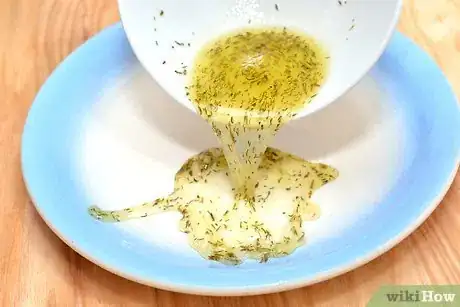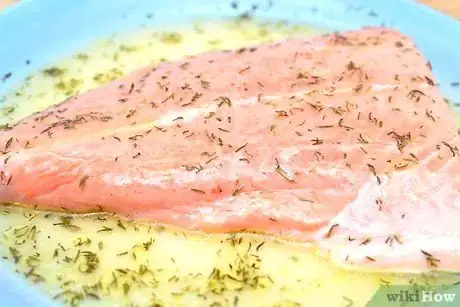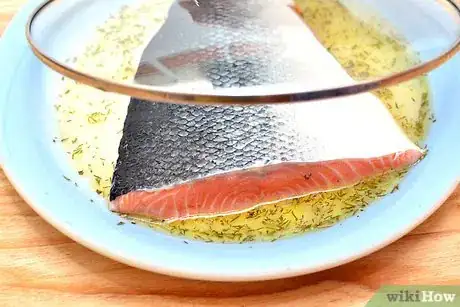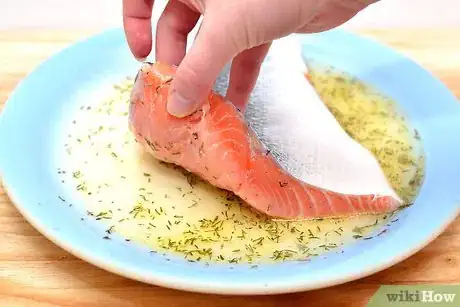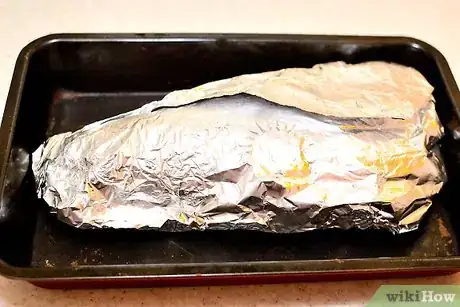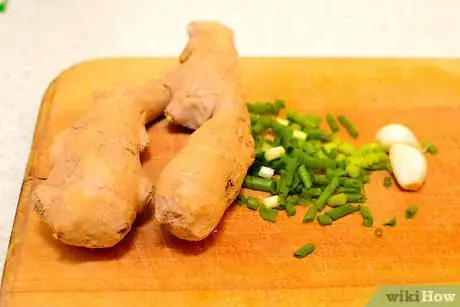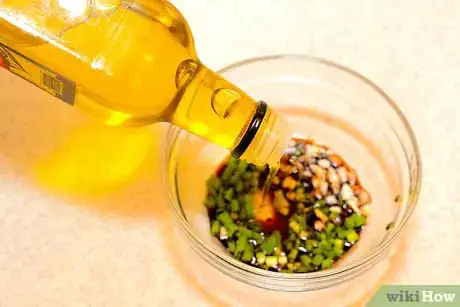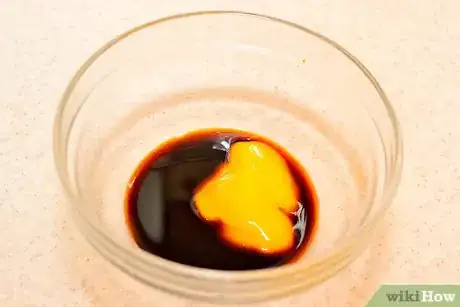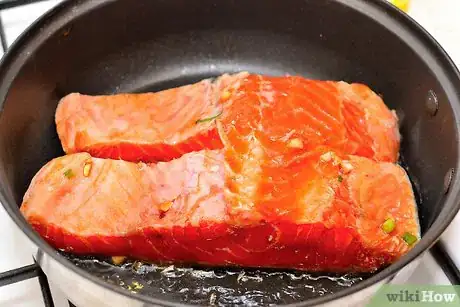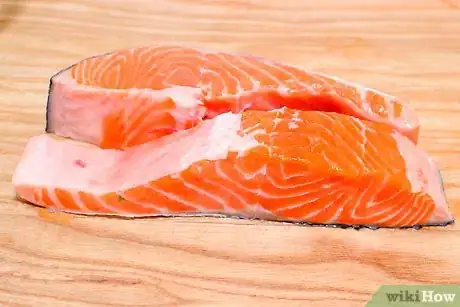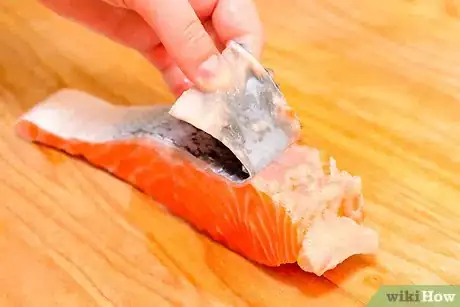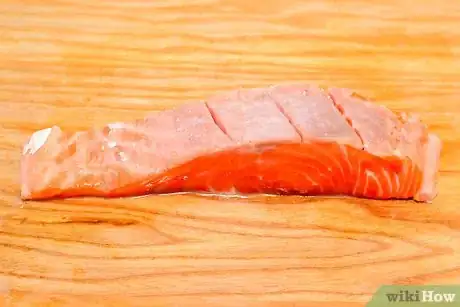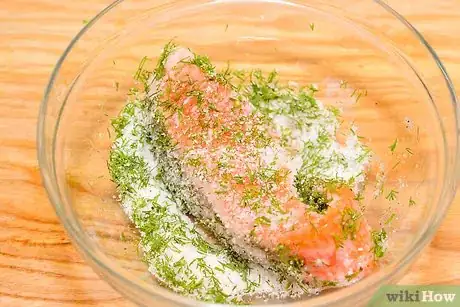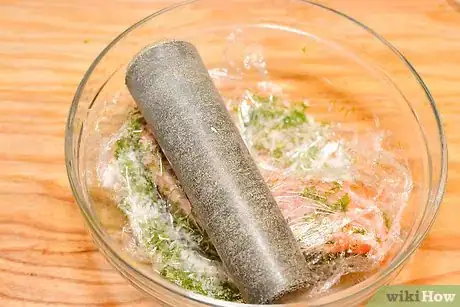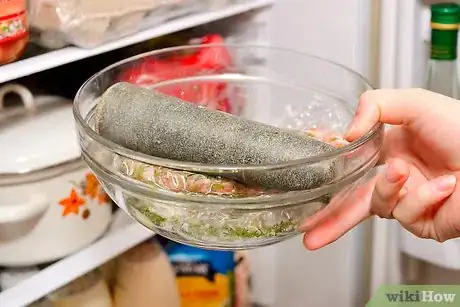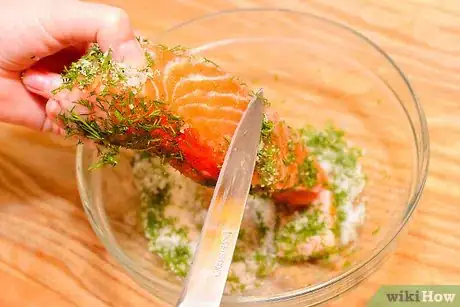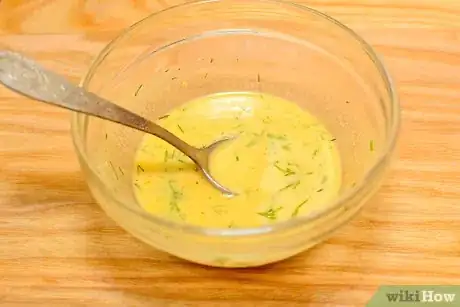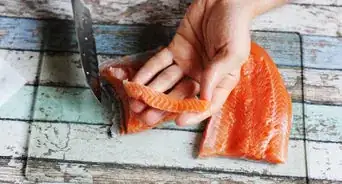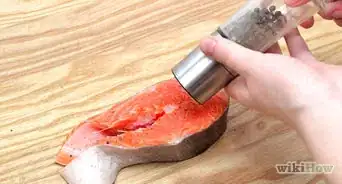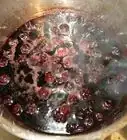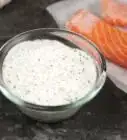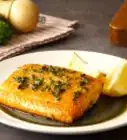This article was co-authored by Ollie George Cigliano. Ollie George Cigliano is a Private Chef, Food Educator, and Owner of Ollie George Cooks, based in Long Beach, California. With over 20 years of experience, she specializes in utilizing fresh, fun ingredients and mixing traditional and innovative cooking techniques. Ollie George holds a BA in Comparative Literature from The University of California, Berkeley, and a Nutrition and Healthy Living Certificate from eCornell University.
There are 10 references cited in this article, which can be found at the bottom of the page.
wikiHow marks an article as reader-approved once it receives enough positive feedback. In this case, 100% of readers who voted found the article helpful, earning it our reader-approved status.
This article has been viewed 587,477 times.
Marinating salmon will enhance its flavor considerably without losing the inherent great taste of the fish. Unlike red meat, fish is best marinated for no more than one hour, or less for more acidic marinades, making it easy to experiment with different flavors. Two marinades are described below, along with a traditional Nordic recipe for raw salmon prepared with its own spice mix.
- Prep time (Lemon Marinade): 10-15 minutes
- Cook time: 15-30 minutes
- Total time: 25-45 minutes
Ingredients
Lemon Marinade:
Servings: 1 to 2
Prep time: 10 min.
Marination time: 15–30 min.
- 1 lb (450 g) salmon fillets
- 1 lemon or 2 limes
- 2 tbsp.(30 mL) olive oil
- 1/2 tsp (2.5 mL) dried thyme, or three sprigs fresh thyme
Soy Sauce Marinade:
Servings: about 2
Prep time: 30 min.
Marination time: 30–60 min.
- 1 lb (450 g) salmon fillets
- 1/4 cup (60 mL) olive oil
- 3 tbsp (45 mL) soy sauce
- 2 garlic cloves, finely chopped or pressed
- 3 scallions, finely chopped
- 1 tbsp (15 mL) fresh ginger, peeled and finely chopped
Glaze:
- 2 tbsp (30 mL) honey
- 1 tsp (5 mL) soy sauce
- 1/2 tsp (2.5 mL) Sriracha, or more to taste
Gravlax:
Servings: About 6
Prep time: 10 min.
Marination time: 24–72 hours
- 26 oz (750 g) fresh salmon fillets (with skin)
- 3¼ oz (85 g) sugar
- 4 oz (120 g) salt
- 8 tbsp (120 mL) chopped dill
- 1 tsp (5 mL) crushed white pepper
Sauce:
- 3 tbsp (45 mL) Swedish or German mustard
- 1 tsp (5 mL) Dijon mustard
- 1 tsp (5 mL) sugar
- 1 tsp (5 mL) vinegar
- salt to taste
- white pepper to taste
- 6 tbsp (90 mL) canola or rapeseed oil
Steps
Marinating in Lemon and Olive Oil
-
1Start this process 30–60 minutes before you plan to eat. Salmon only needs to be marinated for about 15–30 minutes. Start preparing the marinade an hour before you plan to eat, or even less, depending on your cooking method.
- Cooking methods are described at the end of this section.
-
2Squeeze the lemon juice into a bowl. Place the lemon on a cutting board and slice it in half. Squeeze both lemon halves over a bowl..Advertisement
-
3Mix in the other ingredients. Pour 2 tbsp (30 mL) olive oil into the bowl of lemon juice. Add 1/2 tsp (2.5 mL) dried thyme, and stir the ingredients together with a spoon until well mixed.
- Another popular version of this marinade uses dill instead of thyme.
-
4Pour the marinade into a wide dish. Select a dish large enough that all your salmon fillets can fit into it side by side. You may need to use several dishes if you are doubling or tripling the recipe.
- Alternatively, use a large zip locked bag.
-
5Place the salmon in the marinade. Lay the salmon fillets in the dish containing the marinade. Turn them a couple times to make sure each side is covered.
- Food safety experts recommend that you do not wash raw salmon or other raw meat before preparing. Cooking the meat is more effective at killing bacteria, and rinsing the meat is likely to spread the bacteria onto your sink or other places in your kitchen.[1]
- Wash your hands with soap and warm water for twenty seconds after handling raw meat.
-
6Cover and refrigerate for 15–30 minutes, turning once. Unlike red meat and poultry, fish can develop an unpleasant texture during a lengthy marination process. For an acidic marinade such as this one, based on lemon juice, keep the salmon in the marinade for no longer than 30 minutes.[2] Flip the salmon over once during this time to ensure that both sides of the fish are marinated.
-
7Remove the fish from the marinade. Transfer the fish to another container. Discard the remaining liquid. If you wish to use the marinade as a sauce, first bring it to a boil in order to kill harmful bacteria from the raw meat.[3]
-
8Cook the salmon. After the salmon has been marinated, it can be prepared in a number of ways. Two popular options are grilling the salmon wrapped in foil, or baking it on a foil-lined baking sheet. In either case, cook the fillets at 400ºF (200ºC) for about fifteen minutes. The salmon is ready when a fork can easily remove flakes from the surface.
- Flip the salmon halfway through the cooking process if you are grilling it.
Marinating in Soy Sauce and Ginger
-
1
-
2Mix with the other marinated ingredients. Mix the flavorful ingredients together with 1/4 cup (60 mL) olive oil and 3 tbsp (45 mL) soy sauce.
-
3Marinate the salmon. Pour the marinade into a zip locked bag or a wide dish, then place the salmon in the marinade. Refrigerate, turning fillets occasionally, for 30–60 minutes. If you continue to marinade past that point, the texture of the fish may be compromised.
- Because the marinade was in contact with raw fish, it should be discarded after use, or brought to a boil before using as a sauce.
-
4Prepare the glaze (optional). If you like, you can create a glaze to brush onto your salmon for additional flavor during cooking. A simple glaze that pairs well with this marinade is a mixture of 2 tbsp (30 mL) honey, 1 tsp (5 mL) soy sauce, and 1/2 tsp (2.5 mL) Sriracha. Feel free to experiment with the amounts until you find a flavor you enjoy, keeping in mind the glaze may seem overpowering when tasted on its own, rather that eaten on the salmon.
-
5Cook your salmon. Consider pan-searing your salmon to a temperature of 125–140ºF (52–60ºC) on each side.[6] If you do not have a thermometer, avoid overcooking by cooking only skin-side down, briefly cooking the flesh side for only 15–30 seconds once the salmon is opaque but still mostly juicy.
- The skin helps keep the salmon extra flavorful, seal in the juices, and it’s easier to cook. After cooking, you may eat the skin or remove it.
- You may also grill, bake, broil, or poach your salmon after marinading.
Creating Gravlax
-
1Use this recipe to preserve the salmon to eat raw. Gravlax, also called gravad lax, is a traditional Nordic dish which uses salt and sugar to cure the salmon. Various herbs are used to give flavor to the salmon, typically white pepper and dill, and the salmon is eaten raw after the curing process is finished.
- Note: because the salmon is never cooked, keeping preparation surfaces and tools especially clean throughout the process is highly recommended.
-
2Start with fresh, farm-raised salmon. Use high-quality salmon if possible, acquired from a trustworthy source. Using farm-raised salmon is recommended, due to a lower chance of health issues. Although the chance of parasites is not high to begin with, you can reduce the risk further by freezing the salmon first, then defrosting it.[7] [8]
-
3Remove the bones and scales. Use a pair of tweezers or a small knife and fork to remove the scales and bones of the fish.[9] Leave the dark skin beneath the scales attached to the rest of the salmon.
-
4Make several shallow cuts in the skin. These cuts allow the spice mixture to soak into the salmon, giving it more flavor and better preservation.[10]
-
5Mix the dry ingredients together. Chop up one bunch of dill, or about 8 tbsp (120 mL), and crush 1 tsp (5 mL) white peppercorns. Mix these into 3¼ oz (85 g) sugar and 4 oz (120 g) salt.[11] Experienced gravlax chefs will vary the ratios of these ingredients to suit their tastes, but the large quantities of sugar and salt are important so the salmon is properly cured.
-
6Cover the spices with salmon. Heap the spice mix onto the salmon fillets, turning the salmon to make sure it is exposed to the mixture on all sides.
-
7Weigh down the salmon. Place the salmon in a glass or stainless steel container, touching the salmon fillets together on the pink flesh side, rather than the dark skin side.[12] Cover completely with plastic wrap, then press the fish down with any heavy object, such as a brick.
-
8Leave at room temperature for six hours. During this time, the salt and sugar should melt into the salmon, adding a stronger flavor.[13] If you are not comfortable preparing raw food, you may wish to move the fish directly to the refrigerator instead, reducing the risk of bacterial growth.
-
9Refrigerate the fish for one to three days. Move the salmon to the refrigerator, keeping the weight on top of it. The longer you keep it there, the stronger the flavor will be, and the drier the fish will get.[14] Try testing it every 24 hours to see if you enjoy the flavor.
-
10Remove the salmon from the container. Once the salmon has achieved the flavor and texture you prefer, take it out of the container. Scrape off all the spices, and discard any liquid that has been created.[15]
-
11Serve with mustard dill sauce. This common pairing with gravlax can be found at scandinavian food stores. Alternatively, you can make it yourself using the ingredients for the "sauce" listed beneath the gravlax recipe. Mix the mustards, sugar, and vinegar together first, then pour the oil slowly into the mix while stirring. Once it has reached a mayonnaise consistency, stir in the chopped dill and season with white pepper and salt to taste.[16]
- Rye crackers or rye bread are another common food served together with gravlax.
Community Q&A
-
QuestionDoes farm-raised salmon have lower health risks when eaten than wild caught?
 Community AnswerSalmon is a healthy dietary choice whether you choose farm raised or wild caught. Though farm-raised salmon can have lower levels of mercury, both varieties have lower mercury than many other types of food.
Community AnswerSalmon is a healthy dietary choice whether you choose farm raised or wild caught. Though farm-raised salmon can have lower levels of mercury, both varieties have lower mercury than many other types of food. -
QuestionHow do I use lemon caper salmon sauce?
 C GraceCommunity AnswerMarinate and cook your salmon. Make the sauce (or warm it up if it's pre-made), then spoon it over the salmon just before serving.
C GraceCommunity AnswerMarinate and cook your salmon. Make the sauce (or warm it up if it's pre-made), then spoon it over the salmon just before serving. -
QuestionI believe I heard of a recipe for a salmon marinade using Dijon mustard, lemon juice and soy sauce, and I don't remember what else. Can you refresh my memory on this?
 MicheleTop AnswererThere are a number of recipes using those ingredients. You've got the basics, which will work alone, or you can add some chopped garlic, shallots or vinegar. Get more daring and add fish sauce and mirin. Or fresh lemongrass and ginger. Or dill or chives or... The beauty of Marinades is that they can be whatever you like. Make them simple or complicated. If you enjoy the tastes together, that's all that matters.
MicheleTop AnswererThere are a number of recipes using those ingredients. You've got the basics, which will work alone, or you can add some chopped garlic, shallots or vinegar. Get more daring and add fish sauce and mirin. Or fresh lemongrass and ginger. Or dill or chives or... The beauty of Marinades is that they can be whatever you like. Make them simple or complicated. If you enjoy the tastes together, that's all that matters.
Warnings
- Do not marinate the salmon at room temperature, except for the first few hours of a gravlax marination.⧼thumbs_response⧽
Things You’ll Need
- Cutting board
- Sharp knife
- Shallow dish (or resealable plastic bag)
- Measuring spoons
References
- ↑ http://www.npr.org/blogs/thesalt/2013/08/31/216948010/dont-panic-your-questions-on-not-washing-raw-chickens
- ↑ http://www.cheftalk.com/t/67695/how-long-to-marinade
- ↑ http://www.fsis.usda.gov/wps/portal/fsis/topics/food-safety-education/get-answers/food-safety-fact-sheets/safe-food-handling/barbecue-and-food-safety/CT_Index/!ut/p/a1/jZDLCsJADEW_xQ8YkloVXcqA2Kot4mucjUQ7bQd0Ku34_HqrblR8Javk3kPCBQkCpKG9TsjqzND6OsvGAofYcFoc_bDldNALpsOwxzk2R_XSMP9iCNw_-Q_Vxl-8_8eBaj7ggwTklmzKtIkzEImyjExxUHkBIs6yiBUUK3tiMa0sK1KlbClcd-ympmSitTYJiCXlS7XaqRKP2AMJgo8XnonUEWYgn79Cp2wvcEe1rh-4GNZeDW9iuxs-57LdTMS53-6i9ioXHjLtmQ!!/#3
- ↑ http://www.food.com/recipe/the-best-salmon-marinade-286303
- ↑ http://damndelicious.net/2013/11/13/sesame-ginger-salmon/
- ↑ http://www.seriouseats.com/2012/06/how-to-cook-salmon-pan-fry-fish-food-lab.html
- ↑ http://www.food.gov.uk/news-updates/news/2012/jul/fishfreeze#.UoNAK0E_t8E
- ↑ https://sweden.se/culture/food/gravlax
- ↑ http://www.food.com/recipe/gravlax-marinated-salmon-31131
- ↑ https://sweden.se/culture/food/gravlax
- ↑ https://sweden.se/culture/food/gravlax
- ↑ http://www.food.com/recipe/gravlax-marinated-salmon-31131
- ↑ http://www.nytimes.com/1998/11/11/dining/the-minimalist-gravlax-without-fear-a-stunning-dish-just-looks-hard.html
- ↑ http://www.nytimes.com/1998/11/11/dining/the-minimalist-gravlax-without-fear-a-stunning-dish-just-looks-hard.html
- ↑ http://www.food.com/recipe/gravlax-marinated-salmon-31131
- ↑ https://sweden.se/culture/food/gravlax
About This Article
To make a basic lemon and olive oil marinade for salmon, combine the juice of one lemon in a bowl with 2 tablespoons (30 mL) of olive oil and ½ a teaspoon (.46 g) of dried thyme or dill. Mix the ingredients together thoroughly, then pour them into a large, shallow dish. Lay the salmon fillets on the dish and turn them over a few times to make sure both sides are covered thoroughly, then cover the dish and refrigerate it for 15 to 30 minutes. Flip the fillets once about halfway through that time to make sure the marinade soaks into both sides evenly. Then, remove the salmon from the marinade and cook it. For the best results, grill your marinated salmon wrapped in foil or bake it on a foil-lined sheet at 400° F (200° C) for about 15 minutes, or until it flakes easily with a fork. For another flavorful option, chop up 1 tablespoon (about 6 g) of fresh ginger, 2 garlic cloves, and 3 scallions. Mix the aromatic ingredients with ¼ cup (60 mL) of olive oil and 3 tablespoons (45 mL) of soy sauce. Soak your salmon fillets in the mixture in a zipper-top bag for 30-60 minutes. If you like, you can also brush on a glaze of honey, soy sauce, and Sriracha after marinating the salmon. Pan-sear the salmon on each side until the internal temperature reaches between 125 and 140° F (52 to 60° C). If you don’t have a thermometer, cook the salmon skin-side down until it's juicy but opaque all the way through, then sear the flesh side briefly, for about 15-30 seconds. If you prefer raw salmon, try making a delicious gravlax. Remove the bones and scales from a piece of fresh salmon, then make a series of shallow cuts in the skin to make it easier for the spices to soak in. Chop up a single bunch of dill and crush 1 teaspoon (about 2 g) of white pepper. Combine them with 3.25 ounces (85 g) of sugar and 4 ounces (120 g) of salt. Cover all sides of the salmon with your spice mix and wrap it up in plastic wrap, then weigh it down with a heavy object, like a large stone. Allow the salmon to sit at room temperature for 6 hours, then refrigerate it for 1 to 3 days. When you’re ready to eat your gravlax, scrape off the spices and serve it with a traditional mustard dill sauce. To learn how to make a soy and ginger marinade, scroll down!



